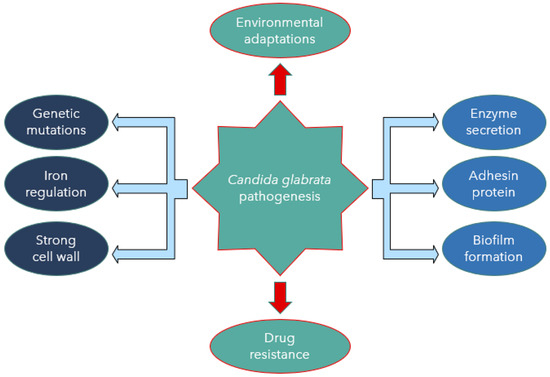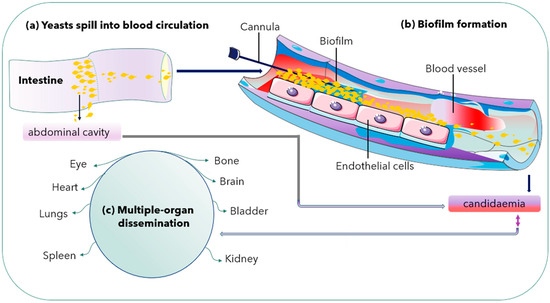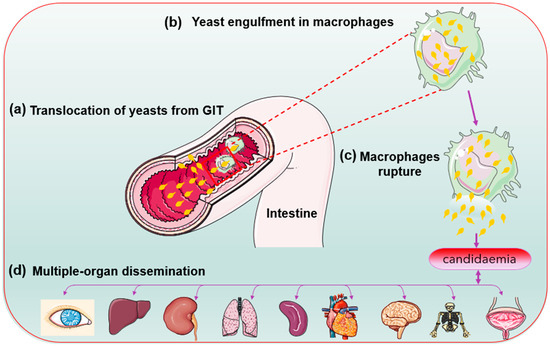1. Introduction
Invasive candidiasis (IC) is a clinical condition that is not associated with a single
Candida species. Each
Candida species holds unique characteristics comparative to invasive potential, virulence, and antifungal susceptibility pattern
[1]. It is an infection with many clinical manifestations that potentially affect any organs. Invasive candidiasis is associated with nosocomial bloodstream infections (BSIs) in tertiary health facilities worldwide
[2].
Candida species also pose a significant threat to patients in the intensive care unit (ICU) with consequential mortality outcomes. They are the most commonly associated health care reported cases
[3]. Major risk factors for
Candida infections include prolonged usage of broad-spectrum antibiotics, immunocompromised state of the host, and the use of medical devices in surgery including catheters
[3][4].
Candida species commonly cause invasive nosocomial infections in immunocompromised patients
[5]. It accounts for 70–90% of all aggressive mycoses
[6]. The increasing isolation of non-
albicans species suggests increasing pathogenicity of these species with varying degrees of clinical symptoms
[7].
Candida glabrata is an asexual, haploid yeast of the clade Nakaseomyces. It was initially named
Cryptococcus glabrata. It then changed to
Torulopsis glabrata in 1894, but the
Candida genus was described in 1913
[8][9].
Candida glabrata is a successful pathogen colonising epithelial surfaces (mouth, gastrointestinal tract, vagina, skin, and present in stool) as healthy microbial flora with no age specificity
[10].
Candida glabrata is commonly found in the environment, particularly on flowers, leaves, surfaces, water, and soil. It is the second most frequently isolated cause of candidiasis after
Candida albicans. It accounts for approximately 15–25% of invasive clinical cases
[8][11][12]. In fact,
C. glabrata is the second most common species found in the United States and North-western Europe
[1][11]. Increasing incidence of
C. glabrata among
Candida species as a cause of BSI in U.S. ICUs between 1989 and 1999 in a survey showed that
C. glabrata ranked second to
C. albicans accounting for 20% to 24% of all
Candida BSIs
[12]. Invasive candidiasis due to
C. glabrata causes substantial morbidity and mortality of approximately 40–60%, perhaps due to the inherent low susceptibility of
C. glabrata to the most commonly used azoles
[3].
The usual route of
C. glabrata to reach the bloodstream is through the breach of natural barriers, such as the use of catheters, trauma, or surgery
[13]. However, disease susceptibility increases due to certain conditions such as AIDS and tuberculosis (TB), immunosuppressive use and cancer drugs, prolonged antibiotic therapy, and prolonged hospitalisation
[14]. Increasing isolation frequency of
C. glabrata is associated with old age, as reported by Zhang et al.
[15]. Accordingly,
C. glabrata was isolated more from patients in the age group >70 years than the other age groups (58.2% vs. 41.8%) out of 193 samples collected. A switch from normal flora to the pathogenic state may occur, leading to disease setting in, ranging from superficial (mucosal and skin) to systemic with an alarming mortality rate
[16].
Virulence refers to the traits required for establishing a disease. However, strictly speaking, virulence factors have direct interaction and causing damage to the host cells
[17]. Changes in the state of either the host or the microbe can affect the degree of virulence
[18]. Many available factors facilitate the pathogenicity of
Candida species. These include enzyme secretion, cellular adhesion, host defence evasion, and biofilm formation
[7]. The infection thrives best in the presence of
Candida species-specific virulence factors such as the presence of hyphae for invasion into host tissues
[19].
Candida albicans filament exists in two distinct morphologies: hyphae and pseudohyphae. The expression of a specific gene set determines each morphology. The morphologies are critical as virulence factors occurring in most
Candida species
[20][21]. However, Galocha et al.
[13] viewed that the pathogenicity of
C. glabrata appears to be independent of the morphology of the yeast as this species is incapable of hyphae formation. Despite that,
C. glabrata lacks several pathogenic attributes, critical in other
Candida species, including polymorphic switching
[22][23]; pathogenic relevance is alarming.
Candida albicans and
C. glabrata show a significant difference in their mechanisms of virulence.
Candida glabrata pathogenicity is associated with many virulence factors
[24]. One of the most crucial factors is that it does not provoke a strong reaction by the host’s immune system. The treatment approach for
C. glabrata infections is challenging due to the limited knowledge of its pathogenicity. The reduced antifungal drug susceptibility and the limited choices of effective antifungal agents are also challenging in treatment, as described by Yu et al.
[25]. Other virulent factors include biofilm formation associated with adherence to host epithelial surfaces and hospital medical devices
[7]. Despite the less destructive nature of
C. glabrata in comparison to
C. albicans, a high mortality rate associated with
C. glabrata and rapidity of disease spread would argue otherwise
[26].
Candida glabrata seems to have evolved a strategy based on secrecy, evasion, and persistence without causing severe damage in murine models
[27]. Skrzypek et al.
[28] also believed that
C. glabrata exhibits a unique escape mechanism from the immune system and subsequently survives cellular engulfment and can resist antifungal treatment (
Figure 1).
Figure 1. Candida glabrata pathogenesis mediated by virulence factors.
3. Drug-Resistance Mechanisms of Candida glabrata
The emergence of antifungal resistance becomes a problem in clinical medicine, significantly when associated with
Candida species. Knowledge of
C. glabrata infection symptoms is essential because
Candida species commonly share indices of suspicion of the disease.
C. glabrata among the non-
albicans Candida species can acquire drug resistance. Moreover, it can develop secondary resistance to other available antifungal classes, resulting in poor treatment outcomes. It is a well-known fact that both
C.
krusei and some
C. glabrata have intrinsic resistance to fluconazole. In such a situation, proper diagnosis is essential to justify appropriate treatment
[59].
The incidence of candidemia caused by fluconazole-resistant strains and derivatives is high
[60]. Azole drugs are among the four classes of antifungals commonly used in clinical practice to treat cancer, AIDS, patients on chemotherapy, and bone marrow transplant patients with fungal infections
[61]. The most prevalent
Candida species,
C.
albicans and
C. glabrata differ significantly in response to antifungal therapy
[62]. Fluconazole is extensively prescribed and administered because of its availability for oral administration, has low toxicity, and is less expensive. However, the extensive use of fluconazole has led to the increasing emergence of resistant isolates
[63][64].
Candida glabrata infections are complicated to treat due to their inherent resistance to antifungals, especially against azoles
[53]. Sardi et al.
[65] viewed that
C. glabrata has intrinsic antifungal resistance, especially to fluconazole. Arendrup and Patterson
[66] argued that
C. glabrata developed acquired resistance to antifungal drugs through prolonged exposure. Moreover, Jensen et al.
[67] supported the view that prolonged administration of antifungal drugs for treatment and prevention is the primary cause of the emergence of resistant strains. The frequency and relatively high mortality rates of these infections are generally associated with pathogenic yeast capacity to efficiently develop multiple drug resistance (MDR).
Moreover,
C. glabrata shows multi-drug-resistant capacity at an alarming rate. The genomes of
C. glabrata can accumulate gene mutations that result in phenotypic resistance to antifungals after exposure to multiple drugs
[68]. For example, mutations in the
MSH2 gene, encoding a DNA mismatch repair protein, occur in
C. glabrata. Its effects have been found in clinical isolates to facilitate the selection of resistance to azoles, echinocandins, and polyenes in vitro
[1]. On a general note, the published in vitro data have shown that deoxycholate amphotericin B (dAmB) and echinocandins such as caspofungin or micafungin demonstrated high activity against
C. albicans and
C. glabrata growing in biofilms settings
[69].



